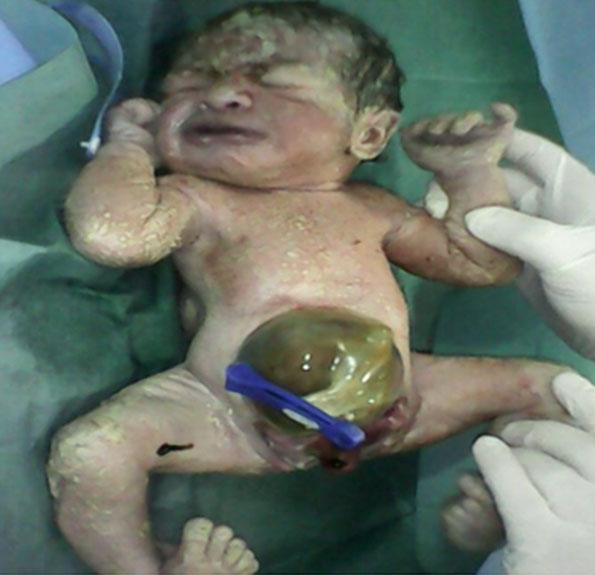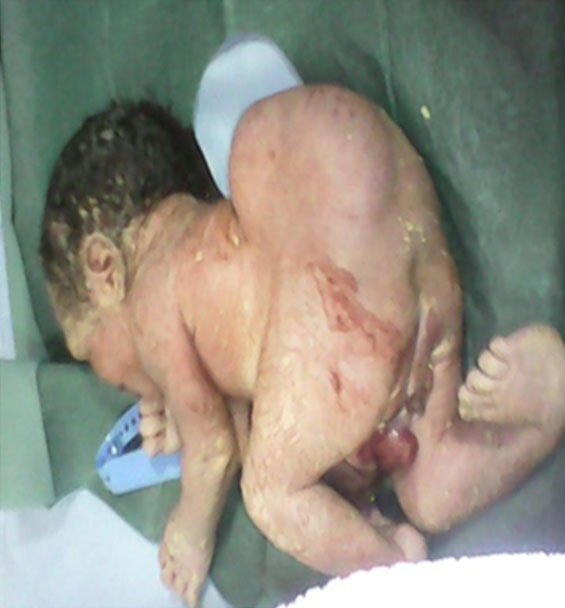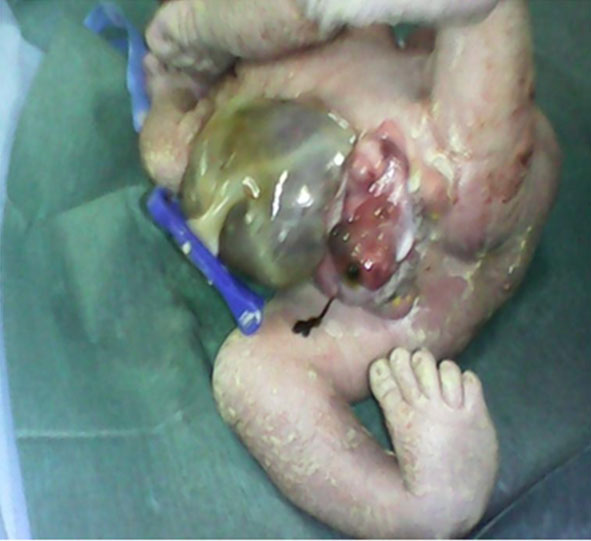 |
Case Report
Diabetes and pregnancy with caudal dysgenesis syndrome: A rare congenital malformation about a case and review of the literature
1 Obstetric Service of Gynaecology I, CHU HassanII, Fès, Morocco
Address correspondence to:
Andatia Malidé
Obstetric Service of Gynaecology I, CHU HassanII, Fès,
Morocco
Message to Corresponding Author
Article ID: 100024G06FG2020
Access full text article on other devices

Access PDF of article on other devices

How to cite this article
Gounain FZ, Malidé A, Mamouni N, Errarhay S, Bouchikhi C, Abdelaziz B. Diabetes and pregnancy with caudal dysgenesis syndrome: A rare congenital malformation about a case and review of the literature. Edorium J Gynecol Obstet 2020;6:100024G06FG2020.ABSTRACT
Maternal diabetes is associated with an increased risk of congenital anomalies, and congenital malformations are the leading cause of infant mortality in the first year. Caudal dysgenesis (CD) has the strongest association with diabetes, occurring up to 200 times more frequently in infants of diabetic mothers than in other infants. Fetal death can be a very emotional event, which can make the search for determining an etiology difficult. Women with diabetes can have complicated pregnancies through a variety of congenital abnormalities, with heart abnormalities being the most common. We report a case of a 34-year-old diabetic type 2 patient plus term pregnancy admitted to the delivery room with intrauterine fetal death and discovery of CD syndrome. In this case report, we describe the characteristics of this rare congenital malformations related to type 2 diabetes and fetal prognosis.
Keywords: Caudal dysgenesis, Diabetes, Fetal death, Pregnancy
INTRODUCTION
Maternal diabetes is associated with an increased risk of birth defects, and birth defects are the leading cause of infant mortality in the first year [1]. Caudal dysgenesis (CD) has the strongest association with diabetes, occurring up to 200 times more frequently in infants of diabetic mothers than in other infants [2]. Caudal dysgenesis, also called caudal regression syndrome or sacral agenesis syndrome, is a rare congenital disorder that affects the development of the lower segment. The term caudal regression syndrome was coined by Duhamel in 1961 to encompass a series of sacrococcygeal malformations [3]. Occurrence numbers for CD range from 1 in 40,000 to 100,000 pregnancies [4],[5]. Fetal death can be a very emotional event, which can make the search for determining an etiology difficult. The ACOG recommends a thorough assessment, including placental and umbilical cord examination, genetic analysis of the fetus, maternal screening for infection, lupus and thyroid problems, and an autopsy if the family allows it [6]. Women with diabetes can have pregnancies complicated by a variety of birth defects, with heart abnormalities being the most common. We report a case of a 34-year-old woman with type 2 diabetes plus term pregnancy admitted to the delivery room with intrauterine fetal death and discovery of CD. In this case report, we describe the characteristics of congenital malformations linked to type 2 diabetes and the fetal prognosis.
CASE REPORT
A 34-year-old female patient, G3P2A1L2, had a family history as a diabetic father and hypertensive mother, known to be diabetic with poor therapeutic adherence admitted to obstetric emergencies for abdominal and pelvic pain of the uterine contraction type associated with decreases in active fetal movements on a pregnancy of 39 weeks of amenorrhea. The pregnancy was not followed. The obstetric examination found a uterine height at 30 cm, an unperceived cardio-fetal noise. The vaginal touch found a dilated cervix 9 cm obliterated 100% with a cephalic presentation. Obstetric ultrasound showed a non-progressive mono-fetal pregnancy, negative cardiac activity, with the presence of a mass in the sacrum and an omphalocele. Biometrics corresponded to 38 weeks of amenorrhea. The labor was fast with a vaginal delivery of a stillbirth presenting: an exstrophy of the bladder, omphalocele and legs in a frog-like position (Figure 1), anal imperforation and myelomeningocele (Figure 2), and a sexual ambiguity (Figure 3). The blood sugar was 2 g/dL.
DISCUSSION
Maternal diabetes is associated with an increased risk of birth defects, and birth defects are the leading cause of infant mortality in the first year [1]. Fetal death can be a very emotional event, which can make the finding for determining an etiology difficult. The ACOG recommends a thorough assessment, including placental and umbilical cord examination, genetic analysis of the fetus, maternal screening for infection, lupus and thyroid problems, and an autopsy if family allowed [6]. The abnormalities appear to be pathognomonic for infants of mothers with diabetes; however, the closest anomaly, with a relative risk of 200–400 is CD [7]. Caudal dysgenesis, also called caudal regression syndrome or sacral agenesis syndrome, is a rare congenital disorder that affects the development of the lower segment. The term caudal regression syndrome was coined by Duhamel in 1961 to encompass a series of sacrococcygeal malformations [3]. Occurrence numbers for CD range from 1 in 40,000 to 100,000 pregnancies [4],[5]. The diagnosis of CD syndrome can be made at the beginning of gestation with ultrasound recognition of a decrease in the length of the croup. Later, ultrasound evaluation will give evidence of a shortened spine with deficits in the lumbar and sacral regions, short femurs, and flexion contractures of the lower extremities [8]. In our case, the diagnosis was not made early because the pregnancy was not followed. The primary defects of CD are agenesis or incomplete development of the lumbar vertebrae, sacrum and coccyx, hypoplastic lower limbs, and anorectal and genitourinary dysgenesis. Depending on the severity of the disease, skeletal malformations affecting the sacrum, coccyx, and lumbar vertebrae cause pelvic deformities and dislocation of the hip. The underdeveloped lower limbs may have malformed knees, absent perils, equinovarus, or calcaneovarus. Infants usually have a “frog leg” position of the lower limbs. Anorectal malformations often involve the displaced or imperforate anus. Urogenital anomalies include malformed or fused kidneys, an absent bladder, and absent or non-ascending external genitalia. Defects in the lower spine include myelomeningoceles or defects in the open spine. We have the same cases of malformations. Different classifications have been proposed to classify CDs according to their severity [8],[9],[10]. Although infants of diabetic mothers tend to have higher rates of abnormalities, they are not doomed to this fate. Several studies have shown that while mothers with higher glycation hemoglobin levels in early pregnancy have higher rates of fetal abnormalities, tight glycemic control both before and throughout pregnancy can decrease these rate [11],[12]. Therefore, pregnant women with diabetes should be counseled extensively on the benefits of maintaining good control of their diabetes.
CONCLUSION
Fetuses from diabetic mothers are at a higher risk of birth defects, including potentially devastating CD syndrome. However, it seems that this risk can be reduced with strict glycemic control before and during pregnancy. While the vast majority of healthcare professionals encourage strict glycemic control in their pregnant patients with diabetes, efforts to monitor pregnancy must be made to find ways to improve patient compliance to reduce incidence of CD syndrome and other diabetic complications.
REFERENCES
1.
Martin JA, Kung HC, Mathews TJ, et al. Annual summary of vital statistics: 2006. Pediatrics 2008;121(4):788–801. [CrossRef]
[Pubmed]

2.
Mills JL. Malformations in infants of diabetic mothers. Teratology 1982;25(3):385–94. [CrossRef]
[Pubmed]

3.
Duhamel B. From the mermaid to anal imperforation: The syndrome of caudal regression. Arch Dis Child 1961;36(186):152–5. [CrossRef]
[Pubmed]

4.
5.
Boulas MM. Recognition of caudal regression syndrome. Adv Neonatal Care 2009;9(2):61–9. [CrossRef]
[Pubmed]

6.
ACOG Practice Bulletin No. 102: Management of stillbirth. Obstet Gynecol 2009;113(3):748–61. [CrossRef]
[Pubmed]

7.
Yang J, Cummings EA, O’connell C, Jangaard K. Fetal and neonatal outcomes of diabetic pregnancies. Obstet Gynecol 2006;108(3 Pt 1):644–50. [CrossRef]
[Pubmed]

8.
Negrete LM, Chung M, Carr SR, Tung GA. In utero diagnosis of caudal regression syndrome. Radiol Case Rep 2015;10(1):1049. [CrossRef]
[Pubmed]

9.
Welch JP, Aterman K. The syndrome of caudal dysplasia: A review, including etiologic considerations and evidence of heterogeneity. Pediatr Pathol 1984;2(3):313–27. [CrossRef]
[Pubmed]

10.
Cama A, Palmieri A, Capra V, Piatelli GL, Ravegnani M, Fondelli P. Multidisciplinary management of caudal regression syndrome (26 cases). Eur J Pediatr Surg 1996;6 Suppl 1:44–5.
[Pubmed]

11.
Miller E, Hare JW, Cloherty JP, et al. Elevated maternal hemoglobin A1c in early pregnancy and major congenital anomalies in infants of diabetic mothers. N Engl J Med 1981;304(22):1331–4. [CrossRef]
[Pubmed]

12.
Kitzmiller JL, Gavin LA, Gin GD, Jovanovic-Peterson L, Main EK, Zigrang WD. Preconception care of diabetes. Glycemic control prevents congenital anomalies. JAMA 1991;265(6):731–6. [CrossRef]
[Pubmed]

SUPPORTING INFORMATION
Author Contributions
Fatime Zahra Gounain - Conception of the work, Design of the work, Acquisition of data, Analysis of data, Drafting the work, Revising the work critically for important intellectual content, Final approval of the version to be published, Agree to be accountable for all aspects of the work in ensuring that questions related to the accuracy or integrity of any part of the work are appropriately investigated and resolved.
Andatia Malidé - Conception of the work, Design of the work, Acquisition of data, Analysis of data, Drafting the work, Revising the work critically for important intellectual content, Final approval of the version to be published, Agree to be accountable for all aspects of the work in ensuring that questions related to the accuracy or integrity of any part of the work are appropriately investigated and resolved.
Nisrine Mamouni - Conception of the work, Design of the work, Acquisition of data, Analysis of data, Drafting the work, Revising the work critically for important intellectual content, Final approval of the version to be published, Agree to be accountable for all aspects of the work in ensuring that questions related to the accuracy or integrity of any part of the work are appropriately investigated and resolved.
Sanaa Errarhay - Conception of the work, Design of the work, Acquisition of data, Analysis of data, Drafting the work, Revising the work critically for important intellectual content, Final approval of the version to be published, Agree to be accountable for all aspects of the work in ensuring that questions related to the accuracy or integrity of any part of the work are appropriately investigated and resolved.
Chahrazad Bouchikhi - Conception of the work, Design of the work, Acquisition of data, Analysis of data, Drafting the work, Revising the work critically for important intellectual content, Final approval of the version to be published, Agree to be accountable for all aspects of the work in ensuring that questions related to the accuracy or integrity of any part of the work are appropriately investigated and resolved.
Banani Abdelaziz - Conception of the work, Design of the work, Acquisition of data, Analysis of data, Drafting the work, Revising the work critically for important intellectual content, Final approval of the version to be published, Agree to be accountable for all aspects of the work in ensuring that questions related to the accuracy or integrity of any part of the work are appropriately investigated and resolved.
Guaranter of SubmissionThe corresponding author is the guarantor of submission.
Source of SupportNone
Consent StatementWritten informed consent was obtained from the patient for publication of this article.
Data AvailabilityAll relevant data are within the paper and its Supporting Information files.
Conflict of InterestAuthors declare no conflict of interest.
Copyright© 2020 Fatime Zahra Gounain et al. This article is distributed under the terms of Creative Commons Attribution License which permits unrestricted use, distribution and reproduction in any medium provided the original author(s) and original publisher are properly credited. Please see the copyright policy on the journal website for more information.







